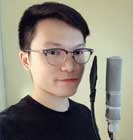Did you know the secret behind the mind boggling speed of TGVs, one of the fastest trains in the world, is the use of electric motors? Not only in transport sector, electric motors find their application in areas as diverse as household appliances, commercial complexes, in devices used for lifting and moving objects and even in toys.
Motors powered by?direct current are referred to as DC motors.
A simple DC motor consists of a rectangular loop PQRS, made of an insulated copper wire. This loop is placed in between two magnets such, that the plane of the loop is parallel to the direction of the magnetic field. The ends of the loop are attached to the two halves, X and Y of a split ring commutator. These halves of the split ring are insulated from each other and are mounted on an axle, about which the rotation is to take place. Externally, two conducting stationary brushes B1and B2 keep pressing against X and Y respectively. These brushes are connected to a DC source. Let us now understand how this assembly works.
Let the current from the battery enter through brush B1, flow through the loop PQRS, and leave through brush B2. Here, the arms QR and SP do not experience any force as they are either parallel or antiparallel to the magnetic field. But the arms, PQ and RS, which are perpendicular to the magnetic field, experience a force each. The direction of this force can be determined using Fleming’s left hand rule. According to this rule, if the first finger points in the direction of the magnetic field and the second finger points in the direction of the current in the conductor,?then the thumb points in the direction of the force exerted on the conductor. Applying this rule on arm RS, we find that, the force acting on it, pushes it upwards. Now, we move on to arm PQ to find the direction of the force acting on it. Here, we notice, that the first finger points in the direction of the magnetic field, but the second finger does not point in the direction of current; so we rotate the left hand such that the second finger points in the direction of current. Notice that, in this case, the thumb points downwards. This implies that the force acting on arm PQ pushes it downwards. Thus, under the action of these two forces acting on arms PQ and RS, having different lines of action, the loop starts rotating anti-clockwise. Just as the rotation starts, arms QR and SP are no more parallel to the magnetic field, and hence are acted upon by the forces as well. But, as the two forces are equal and opposite, and have the same line of action, they always cancel each other.
Once the loop has rotated through 90°, brushes B1 and B2 lose contact with the split ring and the current in the loop is cut off. In the absence of current, arms PQ and RS do not experience any force. This implies that the loop should not rotate any more. However, due to rotational inertia; the loop continues to rotate a little further so that the contact is re-established. Just as that happens, the current starts flowing in the loop once again and the loop continues to rotate in the same anti clockwise direction.
On rotating through 180°, that is, after half rotation, arms PQ and RS of the loop get interchanged. Now, the split ring Y is in contact with brush B1 and X with brush B2 .Therefore, the direction of current flow in arm PQ gets reversed. This happens in arm RS as well. The reversal of current also reverses the direction of forces acting on them. Thus, arm PQ of the loop, which was earlier experiencing a downward force, now experiences an upward force. Likewise, RS experiences a downward force. As a result, the loop continues to rotate anti clockwise. Again, when the loop has turned through an angle of 270°, the brushes and the split ring lose contact; but due to rotational inertia the loop continues to rotate a little further so that the contact is established once again. As soon as that happens, the current starts flowing and due to the forces on arms PQ and RS, the loop continues to rotate until it completes one full rotation of 360°. This whole process is repeated a large number of times so as to obtain continuous rotation of the loop.
Rotational speed of the motor depends upon several factors. Notice how on increasing the number of turns of the coil, the rotational speed increases. On increasing the area of the coil, the speed further picks up. If the current is increased, the rotational speed mounts up further. Finally, if we increase the strength of the magnetic field also, the rotational speed will touch a new high.
In order to achieve high power, a practical DC motor uses an armature coil consisting of a number of coils mounted on a soft iron core. This armature is located in between two or more electromagnets. On passing current through its coils, the armature starts rotating. The rotating armature turns the shaft to which it is attached. Thus, the electrical energy supplied by the source gets converted into mechanical energy.
Motors, powered by?direct current, are referred to as DC motors.
配音业务洽谈QQ:715006566 配音服务热线:0431-85929883
特价配音




